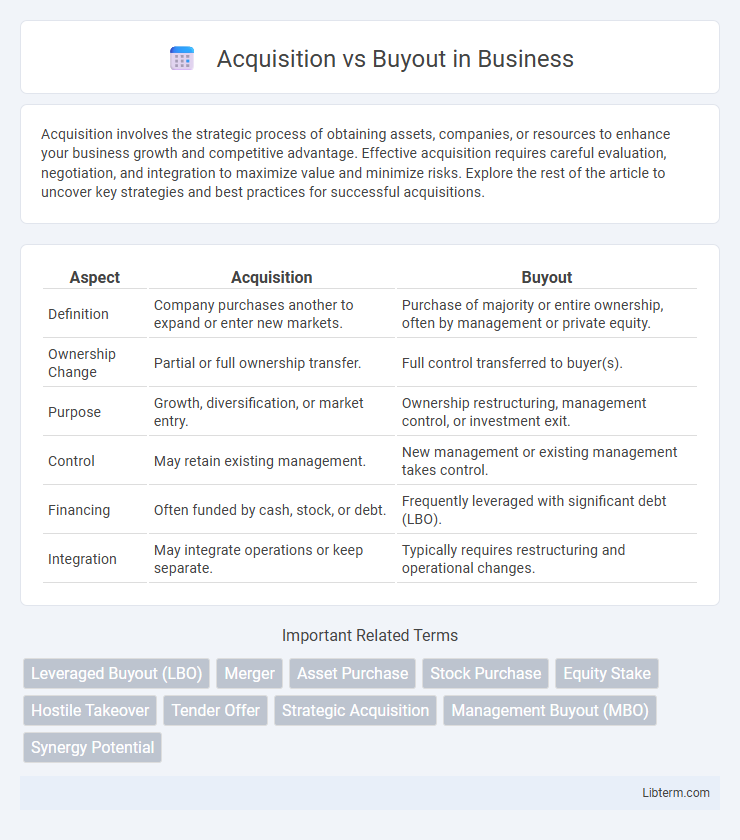Acquisition involves the strategic process of obtaining assets, companies, or resources to enhance your business growth and competitive advantage. Effective acquisition requires careful evaluation, negotiation, and integration to maximize value and minimize risks. Explore the rest of the article to uncover key strategies and best practices for successful acquisitions.
Table of Comparison
| Aspect | Acquisition | Buyout |
|---|---|---|
| Definition | Company purchases another to expand or enter new markets. | Purchase of majority or entire ownership, often by management or private equity. |
| Ownership Change | Partial or full ownership transfer. | Full control transferred to buyer(s). |
| Purpose | Growth, diversification, or market entry. | Ownership restructuring, management control, or investment exit. |
| Control | May retain existing management. | New management or existing management takes control. |
| Financing | Often funded by cash, stock, or debt. | Frequently leveraged with significant debt (LBO). |
| Integration | May integrate operations or keep separate. | Typically requires restructuring and operational changes. |
Introduction to Acquisition and Buyout
Acquisition refers to the process where one company purchases another to gain control and expand its business operations, often involving the transfer of ownership and assets. Buyout typically involves acquiring a controlling interest in a company, frequently led by private equity firms, management teams, or investors aiming to restructure or improve profitability. Both acquisition and buyout serve as strategic tools for growth, market entry, or operational transformation in the corporate landscape.
Defining Acquisition
Acquisition refers to the process where one company purchases most or all of another company's shares to gain control of that company, often allowing for expansion and increased market share. This strategic move can involve buying assets or equity, enabling the acquiring firm to integrate operations and resources effectively. Acquisitions are common in industries seeking growth through diversification or elimination of competition.
What is a Buyout?
A buyout is a financial transaction where a company or investor acquires a controlling interest in a target company, often through purchasing a majority of its shares or assets. This process typically involves private equity firms or management teams aiming to gain full ownership, streamline operations, and enhance value. Buyouts contrast with acquisitions by emphasizing control transfer, often resulting in significant restructuring or strategic shifts.
Key Differences Between Acquisition and Buyout
An acquisition involves one company purchasing another to expand its operations or market reach, often resulting in the acquired company continuing to operate under its existing brand. A buyout typically refers to the purchase of a controlling stake in a company, frequently by private equity firms or management teams, leading to significant changes in ownership and possibly restructuring. Key differences include the scale of control gained, the buyers involved, and the strategic intent behind the transaction.
Types of Acquisitions
Types of acquisitions include horizontal, vertical, concentric, and conglomerate acquisitions, each serving different strategic purposes. Horizontal acquisitions involve purchasing a competitor in the same industry to increase market share, while vertical acquisitions target suppliers or distributors to enhance supply chain control. Concentric acquisitions expand related product lines or services, and conglomerate acquisitions diversify by acquiring companies in unrelated industries for risk reduction.
Types of Buyouts
Types of buyouts include management buyouts (MBOs), where existing management purchases the company, leveraged buyouts (LBOs) involving significant debt to finance the acquisition, and employee buyouts (EBOs) where employees collectively acquire ownership. Buyouts differ from acquisitions primarily in their financing and control structures, often emphasizing internal stakeholders' involvement. Understanding these types is crucial for strategic decisions in corporate restructuring and ownership transitions.
Motivations Behind Each Strategy
Acquisition strategies are typically motivated by the desire to expand market share, acquire new technologies, or enter new geographic areas. Buyouts, often driven by private equity firms, focus on restructuring underperforming companies to enhance value and generate high returns. Both strategies aim to maximize shareholder value but differ in their approach to growth and operational control.
Financial Implications: Acquisition vs Buyout
Acquisitions typically involve purchasing a controlling interest in a company, often requiring significant upfront capital or financing, impacting the buyer's balance sheet and cash flow. Buyouts, particularly leveraged buyouts (LBOs), use a high degree of debt to finance the purchase, increasing financial risk but potentially enhancing returns through debt tax shields and operational improvements. Both strategies affect the firm's capital structure and valuation, with acquisitions leaning towards long-term integration costs and buyouts focusing on debt repayment and exit strategy timing.
Legal Considerations
Acquisition involves one company purchasing another's assets or shares, requiring thorough due diligence on liabilities, contracts, and regulatory compliance to avoid legal disputes. Buyouts, especially management or leveraged buyouts, focus on transaction structure, financing arrangements, and shareholder agreements to ensure lawful transfer of ownership and management control. Both processes demand careful attention to antitrust laws, intellectual property rights, and employment regulations to mitigate legal risks.
Choosing the Right Approach for Your Business
Selecting between an acquisition and a buyout depends on your business goals, financial capacity, and control preferences. Acquisitions allow companies to expand market share and integrate complementary assets without full ownership, while buyouts offer complete control, often requiring significant capital or financing. Evaluating factors such as strategic alignment, long-term growth, and operational autonomy can guide businesses in choosing the optimal approach for sustainable success.
Acquisition Infographic

 libterm.com
libterm.com